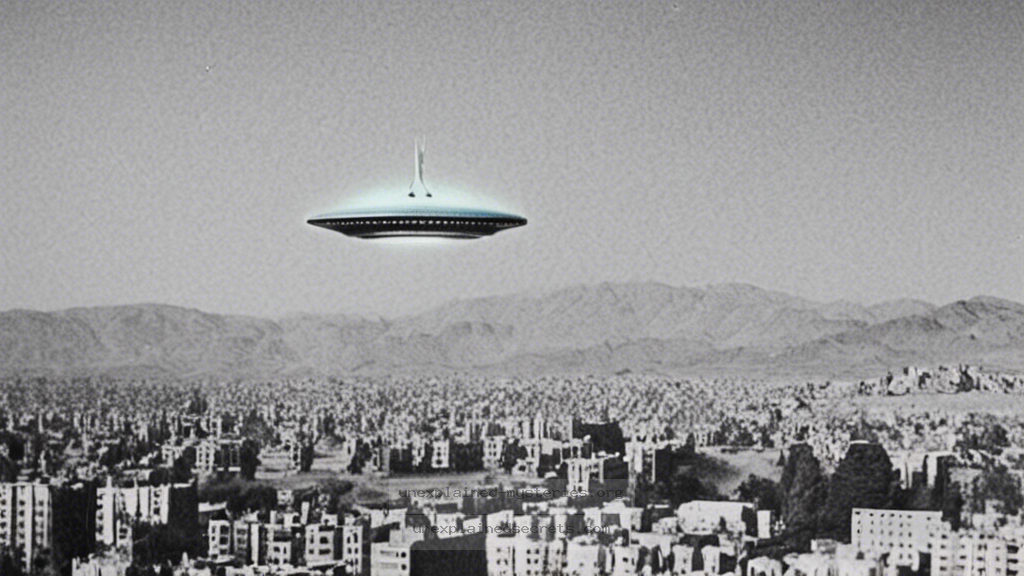What Really Happened During the 1976 Tehran UFO Incident?
What Really Happened During the 1976 Tehran UFO Incident?
The 1976 Tehran UFO incident remains one of the most compelling and mysterious cases in UFO history. On the night of September 19, 1976, Iranian military personnel witnessed a series of unidentified flying objects, leading to a military scramble and a bewildering series of events that have left many questions unanswered. This incident is significant not only because of the nature of the sightings but also due to the involvement of military officials and the implications for national security. In this comprehensive analysis, we will delve into the details of the incident, explore the historical context, examine various theories, and discuss the ongoing implications of this extraordinary event.
Historical Context of the 1976 Tehran UFO Incident
To understand the Tehran UFO incident, it’s essential to explore the political landscape of Iran during the late 1970s. The country was on the brink of the Islamic Revolution, with tensions between the government and various factions escalating. The Iranian military was on high alert due to internal strife and the potential threat from foreign adversaries. This context adds a layer of complexity to the incident as it unfolded against a backdrop of heightened anxiety and suspicion.
On the night of the sightings, Iranian radar operators at the Shahrokhi Air Base in Tehran detected an unidentified object hovering over the city. The military was quick to respond, sending F-4 Phantom II fighter jets to investigate. The urgency of the situation was heightened by the fear of potential airstrikes from neighboring countries, especially amidst the growing tensions in the region.
The Initial Sightings: A Sequence of Events
The incident began around 11:30 PM when radar operators noticed an unusual object on their screens. They reported that the UFO exhibited erratic movements, which raised alarms within the military command. Within minutes, two F-4 jets were dispatched to intercept the unknown craft. As the jets approached, the pilots experienced a series of strange phenomena, including instrument malfunction and an overwhelming sense of disorientation.
One of the pilots, Colonel Parviz Jafari, later recounted that as he closed in on the object, his aircraft’s systems began to fail. The lights on his control panel flickered, and he lost communication with his wingman. In a desperate attempt to regain control, he pulled back from the object, which then reportedly emitted a bright flash before disappearing from sight. This experience was echoed by the other pilot, who also reported similar malfunctions and visual anomalies. The sheer number of witnesses, including military personnel and civilians, adds credibility to the accounts of the sightings.
Core Concepts and Theories Behind the Incident
Several theories have emerged to explain the Tehran UFO incident, ranging from extraterrestrial encounters to secret military technology. One of the most prominent theories posits that the sightings were indeed extraterrestrial crafts visiting Earth. Proponents of this theory point to the detailed observations of the pilots and the unusual behavior of the UFO as evidence of advanced technology beyond human capabilities.
Alternatively, skeptics suggest that the event could have been a case of misidentified aircraft or atmospheric phenomena. Some theorists propose that the military could have been testing advanced radar systems, which could account for the pilots’ instrument failures. It is also plausible that the heightened tensions of the time contributed to a collective psychological experience among the witnesses, leading to a shared but mistaken interpretation of the events.
Evidence and Practical Implications
Key Evidence:
- Multiple radar detections from different military bases.
- Eyewitness accounts from trained military personnel.
- Documented instrument failures during the encounter.
The evidence surrounding the Tehran incident includes radar data and pilot testimonies that collectively paint a vivid picture of an extraordinary encounter. The radar operators’ logs indicate that the object remained stationary for an extended period and exhibited rapid movements that defied conventional flight capabilities. Additionally, the military’s immediate response underscores the seriousness with which they regarded the situation.
One practical implication of the incident is the acknowledgment of unidentified aerial phenomena (UAP) by military institutions worldwide. The U.S. Department of Defense’s recent focus on UAPs reflects a growing recognition that certain sightings may warrant further investigation, especially in light of national security considerations. The Tehran incident serves as a historical case that may encourage contemporary military and governmental organizations to take unexplained aerial phenomena more seriously.
Alternative Perspectives on the Incident
While many view the 1976 Tehran UFO incident as a potential extraterrestrial encounter, others maintain a more skeptical view. Some researchers argue that the military’s response was driven by a combination of fear and misinterpretation of the data. The possibility of advanced military technology being tested during this time cannot be entirely dismissed, and some believe that the pilots may have misinterpreted conventional aircraft as UFOs.
This skepticism is further fueled by the lack of concrete evidence supporting extraterrestrial involvement. While eyewitness accounts are compelling, they do not constitute definitive proof. Critics argue that the psychological state of the witnesses, combined with the political climate, may have created a perfect storm for misidentification and heightened anxiety.
Common Misconceptions and Clarifications
Common Misconceptions:
- All UFO sightings are extraterrestrial in nature.
- The military always has definitive explanations for UFO incidents.
- Eyewitness accounts are always reliable.
One of the most pervasive misconceptions about UFO sightings is the assumption that all such encounters involve extraterrestrial beings. While the term “UFO” implies an unidentified object, it does not inherently denote alien spacecraft. Additionally, the military often encounters phenomena that may remain unexplained but are not necessarily of extraterrestrial origin.
Another common misconception is that military personnel have all the answers regarding UFO sightings. In reality, the complexities of radar technology, atmospheric conditions, and human perception can lead to misunderstandings. Eyewitness accounts can be influenced by a range of factors, including stress and environmental conditions, which may affect the reliability of the testimonies.
Best Practices for Investigating UFO Sightings
For those interested in investigating UFO sightings, there are several best practices to consider. First and foremost, thorough documentation is crucial. Collecting detailed accounts from witnesses, including time, location, and environmental conditions, can provide valuable context.
Additionally, utilizing technology, such as radar analysis and infrared imaging, can enhance the investigation process. Collaborating with experts in various fields, including aviation, psychology, and atmospheric science, can provide well-rounded insights into the phenomena being studied.
Engaging with local communities and encouraging open discussions about UFO sightings can help destigmatize the topic and promote a more collaborative approach to understanding these mysteries. Ultimately, a balanced perspective that considers both skepticism and open-mindedness will yield the most productive results in UFO investigations.
Future Developments and Ongoing Research
The 1976 Tehran UFO incident has prompted ongoing research into UFO phenomena, with various organizations investing in the study of UAPs. The U.S. government has taken significant steps to investigate unexplained aerial phenomena, including the establishment of the Unidentified Aerial Phenomena Task Force (UAPTF) aimed at analyzing and understanding these encounters.
Recent reports have highlighted the need for transparency in sharing information regarding UAP sightings, not only for national security reasons but also to satisfy public curiosity. As technology continues to advance, the potential for capturing and analyzing UFO encounters will improve, leading to a greater understanding of these mysterious incidents.
Conclusion: The Lasting Impact of the Tehran UFO Incident
The 1976 Tehran UFO incident remains a pivotal moment in the history of unidentified aerial phenomena. With its combination of military involvement, credible eyewitness accounts, and the broader implications for national security, it has left an indelible mark on how we perceive UFOs today. As investigations into UAPs continue, the Tehran incident serves as a reminder of the importance of maintaining an open yet critical perspective in the search for answers. Whether one is a skeptic or a believer, the allure of the unknown keeps the conversation vibrant and ongoing.
Other Articles
Recent Posts
- What Happened to Flight MH370? The Conspiracy Theories That Still Haunt Us
- What Secrets Lurk Within the Walls of the Infamous Trans-Allegheny Lunatic Asylum?
- What Evidence Supports the Existence of Bigfoot in the Pacific Northwest?
- What Happened to the Indus Valley Civilization? Unraveling the Mysteries of Ancient Urban Life
- Can Telepathy Be Scientifically Proven Through Laboratory Evidence?







